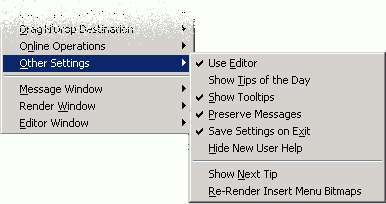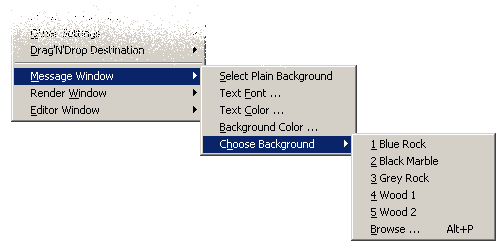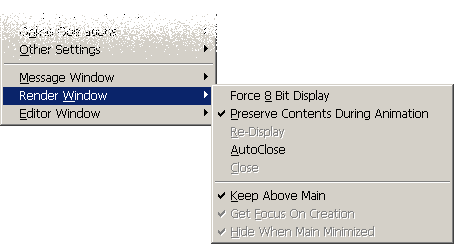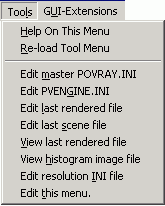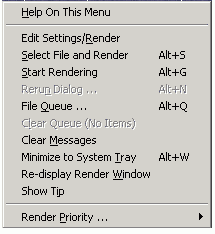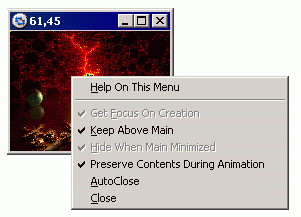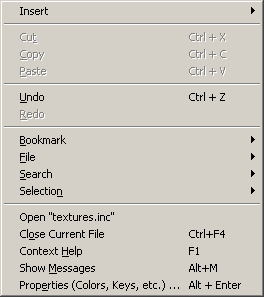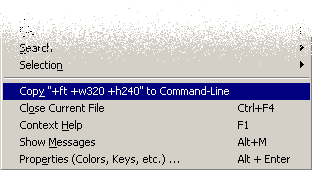Difference between revisions of "Documentation:Windows Section 5.3"
Jholsenback (talk | contribs) m (adjusting section break) |
(Fix nesting in a few places) |
||
| Line 7: | Line 7: | ||
<br> | <br> | ||
<!--</wikitalk>---> | <!--</wikitalk>---> | ||
| − | ===Other Settings=== | + | ====Other Settings sub-menu==== |
{{#indexentry:Options Menu, Other Settings}} | {{#indexentry:Options Menu, Other Settings}} | ||
<table class="centered" width="660x" cellpadding="0" cellspacing="10"> | <table class="centered" width="660x" cellpadding="0" cellspacing="10"> | ||
| Line 20: | Line 20: | ||
<tr> | <tr> | ||
<td> | <td> | ||
| − | <p class="caption">The Other Settings | + | <p class="caption">The Other Settings sub-menu</p> |
</td> | </td> | ||
<td></td> | <td></td> | ||
| Line 26: | Line 26: | ||
</table> | </table> | ||
| − | ====Use Editor==== | + | =====Video Source sub-menu===== |
| + | |||
| + | <p>This sub-menu is designed to allow for selection of a video source for the experimental video image mapping feature. | ||
| + | It is currently disabled pending a re-implementation of the capture code.</p> | ||
| + | |||
| + | =====Use Editor===== | ||
<p>Turns the use of the internal editor on or off.</p> | <p>Turns the use of the internal editor on or off.</p> | ||
| − | ====Show Tips of the Day==== | + | =====Show Tips of the Day===== |
<p>This command lets you decide whether you want POV-Ray for Windows to display the tip of the | <p>This command lets you decide whether you want POV-Ray for Windows to display the tip of the | ||
day on startup. By default, POV-Ray for Windows displays a new tip every time the program is | day on startup. By default, POV-Ray for Windows displays a new tip every time the program is | ||
| Line 35: | Line 40: | ||
has the same effect as selecting the 'Show tip tomorrow' box in the tip screen.</p> | has the same effect as selecting the 'Show tip tomorrow' box in the tip screen.</p> | ||
| − | ====Show Tooltips==== | + | =====Show Tooltips===== |
<p>Turns Tooltips on or off. A Tooltip is a little yellow window that will pop up over a toolbar | <p>Turns Tooltips on or off. A Tooltip is a little yellow window that will pop up over a toolbar | ||
button if you keep the cursor there for long enough. The tip window tells you what the button | button if you keep the cursor there for long enough. The tip window tells you what the button | ||
does.</p> | does.</p> | ||
| − | ====Preserve Messages==== | + | =====Preserve Messages===== |
<p>Whenever you perform a render, POV-Ray for Windows generates a number of messages (active | <p>Whenever you perform a render, POV-Ray for Windows generates a number of messages (active | ||
POV-Ray settings, rendering statistics etc.) in the POV-Ray window. If you select Preserve | POV-Ray settings, rendering statistics etc.) in the POV-Ray window. If you select Preserve | ||
| Line 47: | Line 52: | ||
render. See also Clear Messages in the <!--<linkto "Edit Menu">Edit Menu</linkto>--->[[Documentation:Windows Section 5#Edit Menu|Edit Menu]].</p> | render. See also Clear Messages in the <!--<linkto "Edit Menu">Edit Menu</linkto>--->[[Documentation:Windows Section 5#Edit Menu|Edit Menu]].</p> | ||
| − | ====Save Settings on Exit==== | + | =====Save Settings on Exit===== |
<p>If you select this option, any settings you have selected during your current POV-Ray for | <p>If you select this option, any settings you have selected during your current POV-Ray for | ||
Windows session will be stored for the next one. These include the position and size of the | Windows session will be stored for the next one. These include the position and size of the | ||
Main Window as well the position of the Render Window.</p> | Main Window as well the position of the Render Window.</p> | ||
| − | ====Hide New User Help==== | + | =====Hide New User Help===== |
{{#indexentry:Help On This Menu}} | {{#indexentry:Help On This Menu}} | ||
| Line 58: | Line 63: | ||
menus. We recommend you do this once you're an experienced user.</p> | menus. We recommend you do this once you're an experienced user.</p> | ||
| − | ====Show Next Tip==== | + | =====Show Next Tip===== |
<p>If you do not want to see the tip of the day pop up automatically on startup every day, you | <p>If you do not want to see the tip of the day pop up automatically on startup every day, you | ||
can still see a tip whenever you feel like it. If you select Show Next Tip, POV-Ray for | can still see a tip whenever you feel like it. If you select Show Next Tip, POV-Ray for | ||
Windows displays a single tip but keeps the 'Show tip tomorrow' box unchecked.</p> | Windows displays a single tip but keeps the 'Show tip tomorrow' box unchecked.</p> | ||
| − | ====Re-Render Insert Menu Bitmaps==== | + | =====Re-Render Insert Menu Bitmaps===== |
<p>The preview bitmaps distributed with the POV-Ray for Windows insert menu are of a fairly | <p>The preview bitmaps distributed with the POV-Ray for Windows insert menu are of a fairly | ||
small size in order to keep the size of the distributed setup file down. However, it | small size in order to keep the size of the distributed setup file down. However, it | ||
| Line 72: | Line 77: | ||
running. Eventually all the bitmaps will be replaced with larger ones.</p> | running. Eventually all the bitmaps will be replaced with larger ones.</p> | ||
| − | ====Message Window==== | + | ====Message Window sub-menu==== |
{{#indexentry:Options Menu, Message Window, Message Window Menu}} | {{#indexentry:Options Menu, Message Window, Message Window Menu}} | ||
<table class="centered" width="660x" cellpadding="0" cellspacing="10"> | <table class="centered" width="660x" cellpadding="0" cellspacing="10"> | ||
| Line 85: | Line 90: | ||
<tr> | <tr> | ||
<td> | <td> | ||
| − | <p class="caption">The Message Window | + | <p class="caption">The Message Window sub-menu</p> |
</td> | </td> | ||
<td></td> | <td></td> | ||
| Line 91: | Line 96: | ||
</table> | </table> | ||
| − | ====Select Plain Background==== | + | =====Select Plain Background===== |
<p> | <p> | ||
| − | + | If you have chose a background image for the message window and want to change back to | |
| − | + | a plain color, you can select this command. The background takes on the currently defined | |
background color (see Background Color below). | background color (see Background Color below). | ||
</p> | </p> | ||
| − | ====Text Font==== | + | =====Text Font===== |
<p> | <p> | ||
Use this command to determine the font POV-Ray for Windows uses to display messages and | Use this command to determine the font POV-Ray for Windows uses to display messages and | ||
| Line 107: | Line 112: | ||
<p class="Note"><strong>Note:</strong> If you select italic text, this setting will not be preserved across invocations of POV-Ray.</p> | <p class="Note"><strong>Note:</strong> If you select italic text, this setting will not be preserved across invocations of POV-Ray.</p> | ||
| − | ====Text Color==== | + | =====Text Color===== |
<p> | <p> | ||
This command lets you determine which text color best fits the background you have selected | This command lets you determine which text color best fits the background you have selected | ||
| − | for the | + | for the message window. |
</p> | </p> | ||
| − | ====Background Color==== | + | =====Background Color===== |
<p> | <p> | ||
This command lets you select the color of the plain background for the Main Window. Note that | This command lets you select the color of the plain background for the Main Window. Note that | ||
| Line 120: | Line 125: | ||
</p> | </p> | ||
| − | ====Tiling Options==== | + | =====Tiling Options===== |
<p> | <p> | ||
You can change the tiled bitmap POV-Ray for Windows displays in its message window. Choosing | You can change the tiled bitmap POV-Ray for Windows displays in its message window. Choosing | ||
| Line 130: | Line 135: | ||
corner of the Main Window and displays as much of it as the Main Window allows.</p> | corner of the Main Window and displays as much of it as the Main Window allows.</p> | ||
| − | <p> Note that | + | <p> Note that because of the POV-Ray for Windows generalized palette, if you are running in 256-color mode, |
| − | because of the POV-Ray for Windows generalized palette, if you are running in 256-color mode, | ||
external bitmaps may not tile 100% perfectly, and the colors may be slightly altered. If you | external bitmaps may not tile 100% perfectly, and the colors may be slightly altered. If you | ||
are running in 16-color mode, tiled backgrounds are not available at all. In practice, | are running in 16-color mode, tiled backgrounds are not available at all. In practice, | ||
| Line 138: | Line 142: | ||
</p> | </p> | ||
| − | ====Render Window==== | + | ====Render Window sub-menu==== |
{{#indexentry:Options Menu, Render Window, Render Window Menu}} | {{#indexentry:Options Menu, Render Window, Render Window Menu}} | ||
<table class="centered" width="660x" cellpadding="0" cellspacing="10"> | <table class="centered" width="660x" cellpadding="0" cellspacing="10"> | ||
| Line 151: | Line 155: | ||
<tr> | <tr> | ||
<td> | <td> | ||
| − | <p class="caption">The Render Window | + | <p class="caption">The Render Window sub-menu</p> |
</td> | </td> | ||
<td></td> | <td></td> | ||
| Line 157: | Line 161: | ||
</table> | </table> | ||
| − | ====Force 8 Bit Display==== | + | =====Force 8 Bit Display===== |
<p> | <p> | ||
POV-Ray for Windows is capable of displaying a rendering scene in 24-bit color (Truecolor). | POV-Ray for Windows is capable of displaying a rendering scene in 24-bit color (Truecolor). | ||
| Line 174: | Line 178: | ||
</p> | </p> | ||
| − | ====Preserve Contents During Animation==== | + | =====Preserve Contents During Animation===== |
{{#indexentry:animation, preserving window contents during}} | {{#indexentry:animation, preserving window contents during}} | ||
| Line 189: | Line 193: | ||
</p> | </p> | ||
| − | ====Re- | + | =====Re-Display===== |
| − | {{#indexentry:Re- | + | {{#indexentry:Re-Display Render Window}} |
<p> | <p> | ||
| Line 202: | Line 206: | ||
</p> | </p> | ||
| − | ====Autoclose==== | + | =====Autoclose===== |
<p> | <p> | ||
This causes the Render window to close automatically when rendering is complete. This is | This causes the Render window to close automatically when rendering is complete. This is | ||
| Line 208: | Line 212: | ||
</p> | </p> | ||
| − | ====Close==== | + | =====Close===== |
<p> | <p> | ||
This command closes the Render Window. This does not interfere with any rendering activity. | This command closes the Render Window. This does not interfere with any rendering activity. | ||
| Line 220: | Line 224: | ||
</p> | </p> | ||
| − | ====Keep Above Main==== | + | =====Keep Above Main===== |
<p> | <p> | ||
If you make the POV-Ray for Windows Main Window active with Keep Above Main deselected, the | If you make the POV-Ray for Windows Main Window active with Keep Above Main deselected, the | ||
| Line 234: | Line 238: | ||
</p> | </p> | ||
| − | ====Get Focus on Creation==== | + | =====Get Focus on Creation===== |
<p> | <p> | ||
This command causes the POV-Ray window to get focus (pop to the foreground and become active) | This command causes the POV-Ray window to get focus (pop to the foreground and become active) | ||
| Line 257: | Line 261: | ||
</p> | </p> | ||
| − | ====Hide When Main Minimized==== | + | =====Hide When Main Minimized===== |
<p> | <p> | ||
If you have 'Keep Above Main' turned off, the main POV-Ray window and the Render Window are | If you have 'Keep Above Main' turned off, the main POV-Ray window and the Render Window are | ||
| Line 269: | Line 273: | ||
</p> | </p> | ||
| − | ====Editor Window==== | + | ====Editor Window sub-menu==== |
<p> | <p> | ||
| − | This sub-menu is identical to the main <!--<linkto "Editor Menu">Editor Menu</linkto>--->[[Documentation:Windows Section 5.1#Editor Menu|Editor Menu]]. It is | + | This sub-menu is identical to the main <!--<linkto "Editor Menu">Editor Menu</linkto>--->[[Documentation:Windows Section 5.1#Editor Menu|Editor Menu]]. It is included in the Options Menu for consistency. |
| − | included in the Options Menu for consistency. | ||
</p> | </p> | ||
Revision as of 02:25, 2 February 2013
|
This document is protected, so submissions, corrections and discussions should be held on this documents talk page. |
|
This sub-menu contains a number of less-commonly-used options so as to reduce clutter in the main options menu. |
|
|
The Other Settings sub-menu |
This sub-menu is designed to allow for selection of a video source for the experimental video image mapping feature. It is currently disabled pending a re-implementation of the capture code.
Use Editor
Turns the use of the internal editor on or off.
Show Tips of the Day
This command lets you decide whether you want POV-Ray for Windows to display the tip of the day on startup. By default, POV-Ray for Windows displays a new tip every time the program is started more than 24 hours after the previous tip was shown. Selecting Show Tips of the Day has the same effect as selecting the 'Show tip tomorrow' box in the tip screen.
Show Tooltips
Turns Tooltips on or off. A Tooltip is a little yellow window that will pop up over a toolbar button if you keep the cursor there for long enough. The tip window tells you what the button does.
Preserve Messages
Whenever you perform a render, POV-Ray for Windows generates a number of messages (active POV-Ray settings, rendering statistics etc.) in the POV-Ray window. If you select Preserve Messages, POV-Ray for Windows retains all messages generated during the current session. If you deselect this option, all existing messages are deleted every time you perform a new render. See also Clear Messages in the Edit Menu.
Save Settings on Exit
If you select this option, any settings you have selected during your current POV-Ray for Windows session will be stored for the next one. These include the position and size of the Main Window as well the position of the Render Window.
Hide New User Help
Selecting this option will cause the 'Help On This Menu' entries to be removed from all menus. We recommend you do this once you're an experienced user.
Show Next Tip
If you do not want to see the tip of the day pop up automatically on startup every day, you can still see a tip whenever you feel like it. If you select Show Next Tip, POV-Ray for Windows displays a single tip but keeps the 'Show tip tomorrow' box unchecked.
Re-Render Insert Menu Bitmaps
The preview bitmaps distributed with the POV-Ray for Windows insert menu are of a fairly small size in order to keep the size of the distributed setup file down. However, it is easy to re-render them all at a larger size (though it may take a while on a slower computer).
Just select the 'Re-Render Insert Menu Bitmaps' option and leave POV-Ray for Windows running. Eventually all the bitmaps will be replaced with larger ones.
|
This sub-menu allows you to set certain properties of the message window. |
|
|
The Message Window sub-menu |
Select Plain Background
If you have chose a background image for the message window and want to change back to a plain color, you can select this command. The background takes on the currently defined background color (see Background Color below).
Text Font
Use this command to determine the font POV-Ray for Windows uses to display messages and statistics. In addition to the type of (non-proportional) font, you can set font size and appearance. POV-Ray for Windows remembers the font setting between sessions.
Note: If you select italic text, this setting will not be preserved across invocations of POV-Ray.
Text Color
This command lets you determine which text color best fits the background you have selected for the message window.
Background Color
This command lets you select the color of the plain background for the Main Window. Note that this command has no effect while you have tiled the background with a bitmap. The color only becomes visible when you select Plain Background (see above).
Tiling Options
You can change the tiled bitmap POV-Ray for Windows displays in its message window. Choosing Tiling Options brings up a sub-menu where you can select one of several built-in bitmaps. You can also browse your disk for other bitmaps you might prefer. POV-Ray for Windows pre-installs a number of them in the TILES subdirectory of your POV-Ray for Windows home directory. The bitmaps should have no more than 256 colors. If the BMP file you select is smaller than the Main Window, it will be tiled. If it is larger, POV-Ray for Windows fits it into the top-left corner of the Main Window and displays as much of it as the Main Window allows.
Note that because of the POV-Ray for Windows generalized palette, if you are running in 256-color mode, external bitmaps may not tile 100% perfectly, and the colors may be slightly altered. If you are running in 16-color mode, tiled backgrounds are not available at all. In practice, choosing tileable bitmaps other than the standard Marble one, using a 256-color display, will often not yield attractive results.
|
This sub-menu allows you to set certain properties of the render window. |
|
|
The Render Window sub-menu |
Force 8 Bit Display
POV-Ray for Windows is capable of displaying a rendering scene in 24-bit color (Truecolor). This takes up more RAM than 8-bit mode: 3 bytes for every pixel in the rendered scene. If you do not have enough RAM to spare, you should select this option. It forces POV-Ray for Windows to display the scene in 8-bit color (1 byte per pixel) and to use color dithering to represent the rendered image on the screen. If you are already using a 256-color video mode it does not make any difference since the image is already stored as one byte per pixel. Note that this does not change the way that the rendered image is stored on disk. If you are writing an output file, the file will still be 24-bit color!
In 15 or 16 bit color modes, the image is stored in memory as 24-bit but only displayed as 15 or 16 bit. No dithering is (currently) performed in these modes.
Preserve Contents During Animation
If this option is enabled (the default) and you are rendering an animation, the contents of the render window (which shows the previous frame of the animation) are not erased prior to a new frame being started. This makes it easier to see subtle changes in the image output (such as a small object moving from frame to frame, while the rest of the image stays static).
Note that the render window contents are always erased prior to the first frame, regardless of the setting of this option.
Re-Display
If the Render Window is closed (see Close below), you can re-display it by selecting this command. If the window is not closed in the first place (or has never been displayed), you cannot re-display it, and so the Re-display command is grayed.
Note that this command is also available on the toolbar.
Autoclose
This causes the Render window to close automatically when rendering is complete. This is particularly useful if you're doing quick test renders at low resolution.
Close
This command closes the Render Window. This does not interfere with any rendering activity. Indeed, it speeds up rendering (see also Speed Considerations). To re-display the Render Window, select Re-display, use the right-mouse button speed menu on the message window, or simply click the 'Show' toolbar button.
Note that this command is also available on the toolbar.
Keep Above Main
If you make the POV-Ray for Windows Main Window active with Keep Above Main deselected, the rendering window may still be obscured by the main or any other window. Selecting Keep Above Main ensures that the rendering window pops up from under other windows whenever you make POV-Ray for Windows active. Note that if this option is set, you cannot hide the render window behind the main window (this can be a problem if you are rendering at the same time you are editing; hence the ability to set both modes via this option).
Note: If you enable this option, the 'Get Focus on Creation' and 'Hide When Main Minimized' options detailed below will be grayed out.
Get Focus on Creation
This command causes the POV-Ray window to get focus (pop to the foreground and become active) whenever a new file is processed. If POV-Ray for Windows is processing a file queue or animation, the POV-Ray Main Window gets focus every time a new file is initialized from the top of the queue, or a new pass over the animation source file is performed. This only applies, of course, if you are using the render window.
If you want to do other work on your Windows machine while POV-Ray is rendering, but you have the render window displayed, you will probably want to have this option off since otherwise the window will keep on popping up over whatever you are doing, each time a new image is rendered.
Hint: A handy shortcut to remember is that hitting the Escape key when the render window gets focus will return focus to the main window. This is particularly useful after a quick test render.
Note: If the 'Keep Above Main' option documented above is enabled, this option will be grayed out. This is because 'Keep Above Main' implies 'Get Focus On Creation'. If you don't want the render window to get focus on creation, you will need to turn 'Keep Above Main' off.
Hide When Main Minimized
If you have 'Keep Above Main' turned off, the main POV-Ray window and the Render Window are no longer linked. You now have the option of continuing to show the Render Window whenever the Main Window is minimized. If you select this option, the Render Window disappears as soon as you minimize the Main Window.
Note: If the 'Keep Above Main' option documented above is enabled, this option will be grayed out. This is because 'Keep Above Main' implies 'Hide When Main Minimized'. If you don't want the render window to be hidden when the main window is minimized, you will need to turn 'Keep Above Main' off.
This sub-menu is identical to the main Editor Menu. It is included in the Options Menu for consistency.
Tools Menu
|
The Tools Menu provides you with a simple means of customizing POV-Ray for Windows. You can develop your own commands (up to 32) to show up under this menu. Since the menu is determined by the file PVTOOLS.INI, editing and reloading this INI file changes the Tools Menu. |
|
|
The Tools Menu |
PVTOOLS.INI Syntax
The syntax of entries in PVTOOLS.INI is as follows:
[Menu] ItemN=Description [Command] ItemN=command_string [Help] ItemN=help_line
Where N is a number between 0 and 31, and entries in the [Help] section are optional.
Item0 ... Item31
are the item numbers that define the order in which entries appear in the Tools Menu.
[Menu]
Entries in the [Menu] section are what actually appears in the Tools Menu. The '&'
character tells Windows where to put the underline in the menu entry. The underlined letter
becomes the abbreviation for the command. For example the letter 'C' in '&Click Me' would
become 'Click Me' when displayed in the Tools Menu, and you could access the command by
pressing Alt+T and then 'C'. (Alt+T activates the Tools Menu).
You should make sure that all Tools Menu entries have different abbreviations if you intend to
access them this way. Of course, you don't have to supply any abbreviation if you don't want
to.
Note: By default newer versions of Windows will not display the underline beneath the abbreviation until you press ALT. This means if you use the mouse to open the menu you won't see the underlines.
[Command]
This is the command that POV-Ray will execute for that entry. This can be a Windows EXE, a batch
file, or anything else that may be executed by the Win32 ShellExecute() API call. The command
consists of the actual command name followed by any parameters you want to supply to the program.
There are two special commands, '$S' and '$E'. $S means 'use the shell association for the
filename that follows it', and '$E' means 'open the following file in the internal POVWIN editor'.
Let's look at an example -
Item4=$S %1
Since %1 refers to the output file (see below) this means that Item 4 of the tools menu
expands to a command to Windows to open the last output file with whatever program is
associated with it. For example, if the last output file was 'c:\images\torus4.png' then the
above command example would use whatever program is associated with PNG files (i.e. the
program that Windows runs if you double-clicked on the TORUS4.PNG file in Windows Explorer) to
open it.
Note: If using the $S or $E special commands, do not quote the parameters with '"', even if they will have spaces in them. Both of these commands may only be supplied a single parameter, which is taken to be the entire line following the command.
POV-Ray for Windows has a number of pre-defined parameters that you can substitute into the command line before the program is run. These are defined by a percent sign ('%') followed by a letter or number. For example, '%i' means substitute the POV-Ray for Windows INI file directory in the place of the '%i'.
Let's look at the command:
notepad.exe %ipvtools.txt
If you had installed POV-Ray for Windows into the directory 'c:\povwin3', then our standard
INI file directory would be 'c:\povwin3\ini\'. When POV-Ray ran the above command, the '%i'
would be replaced with 'c:\povwin3\ini\'. Note that the trailing '\' is provided by POV-Ray.
This means that:
notepad.exe %ipvtools.txt
would become:
notepad.exe c:\povwin3\ini\pvtools.txt
Here are all of the predefined substitutions:
| %0 |
The contents of the 'SourceFile' entry of the 'LastRender' section in PVENGINE.INI. This will be the input file provided to POV-Ray for the most recent render. This information is extracted from the rendering engine itself, rather than any input dialog or command-line. It is the file which, after all processing of the command line and INI files was complete, was finally assigned as the input file. |
| %1 |
The contents of the 'OutputFile' entry of the 'LastRender' section in PVENGINE.INI. This will be the output file from the last render, if any. This entry could be blank. |
| %2 |
The contents of the 'SceneFile' entry of the 'LastRender' section in PVENGINE.INI. This will
be the scene file name for the last render, without the tga2gif %d\%1 %2.gif could expand to: tga2gif c:\scenes\myscene.tga myscene.gif assuming the input file was |
| %4 |
The contents of the 'IniOutputFile' entry of the 'LastRender' section in PVENGINE.INI. If you had instructed POV-Ray to write an INI file from the last render, this would contain its name. |
| %D |
The contents of the 'CurrentDirectory' entry of the 'LastRender' section in PVENGINE.INI. This is the current working directory that was set on your machine when POV-Ray began rendering the last file, and is what the other output file entries are probably relative to. You may need to provide '%d' with some of these other entries to get the full path. |
| %H |
The POV-Ray for Windows install directory, as specified in the registry or inferred at run-
time, e.g. ' |
| %P |
The POV-Ray for Windows user documents directory, as specified in the registry or inferred at run-
time, e.g. ' |
| %I |
The POV-Ray for Windows INI directory. e.g. ' |
| %N |
The preset INI filename, as used in the render options dialog. |
| %R |
The last render file (with full path) as supplied to POV-Ray from the render or choose file dialog. This is not necessarily the same thing as %S or %0. |
| %S |
The source file name as provided to POV-Ray on the last render of the current session. This is not necessarily the same thing as the %0 or %R directive. For example, %R will never provide the path to a file that was rendered via the File Queue without the use of the Command dialog. %S will, however, include any such file. |
| %T |
The full path to |
| %% |
A literal percent character ('%'). |
If any of the above seems confusing, there's an easy way to find out what's going on. If you
place the statement DEBUG=1 in the General section of PVTOOLS.INI, POV-Ray for Windows will
print out the string for each command both before and after it is expanded, instead of running
the command that you select in the tool menu. That way you can see exactly what POV-Ray
substitutes. The printout will be visible in the messages window.
For example:
[General] Debug=1
will turn on debugging. while
[General] Debug=0
or omitting the statement entirely turns it off.
[Help]
You can have a help line appear in the status bar at the bottom of the window. You don't have to supply this entry if you don't want to.
Example:
[Help] Item1=Edit master POVRAY.INI in installation directory
This command makes the string 'Edit master POVRAY.INI in installation directory' appear on the status bar when the mouse is over the 1st item in the Tools menu.
Reload Tool Menu
If you want your changes to take immediate effect after you have edited PVTOOLS.INI using a text editor, you have to select the Tools Menu command Reload Tool Menu to instruct POV-Ray for Windows to re-read the INI file and activate the new settings.
Edit PVTOOLS.INI
This standard Tools Menu command lets you modify PVTOOLS.INI using the Notepad editor. The command is part of PVTOOLS.INI itself, which means you may delete it entirely if you don't want it. It is present by default in the standard distribution of POV-Ray for Windows.
Example PVTOOLS.INI
[Menu] Item0=Edit &master POVRAY.INI Item1=Edit &last rendered file Item2=Edit last &scene file Item3=&View last rendered file Item4=View &histogram image file Item5=Edit resolution &INI file Item6=Edit &this menu. [Command] # NOTE! If using the Shell Open command ($S), DO NOT quote the parameters with '"' Item0=notepad.exe "%hrenderer\povray.ini" Item1=notepad.exe "%r" Item2=notepad.exe "%0" Item3=$S %1 Item4=$S %3 Item5=notepad.exe "%n" Item6=notepad.exe "%t" [Help] Item0=Edit master POVRAY.INI in installation directory Item1=Edit the last file that POV-Ray was rendering Item2=Edit the last scene file that you selected Item3=View the output of the last render (assumes file output was on) Item4=View the histogram of the last render (assumes histogram image output was on) Item5=Edit secondary INI file as specified in Command-line dialog. Item6=Edit PVTOOLS.INI to alter this menu [General] Debug=0
Context Menus
Most POV-Ray windows have shortcut (also known as 'context') menus. You access them by right-clicking over the window in question (e.g. the message, edit, or render window). The menu that appears will have the most commonly-used commands (as available in the main menus) that apply to that particular type of window.
The Message Window Context Menu
|
When the mouse right button is pressed over the Message window, a pop-up menu containing these commands are displayed: |
|
|
The Message Window Context Menu |
All of these commands and sub-menus except 'Minimize to System Tray' and 'Show Tip' are documented elsewhere; the following list links to that documentation.
- Edit Settings/Render
- Select File and Render
- Start Rendering
- File Queue
- Clear Queue
- Clear Messages
- Re-display Render Window
- Render Priority
Minimize to System Tray
This command (which is also available as a toolbar button) will hide POV-Ray for Windows and place a small icon in the system tray (the system tray usually contains a clock and is often at the right hand side of the task bar at the bottom of the screen).
You can use the right-mouse button on this icon to get a context menu. Double-clicking on it restores POVWIN from the tray.
Show Tip
If you select Show Tip, POV-Ray for Windows displays a single tip (see Show Tips of the Day).
The Render Window Context Menu
|
When the mouse right button is pressed over the Render window, a pop-up menu containing these commands are displayed: |
|
|
The Render Window Context Menu |
See the Render Window sub-menu for documentation on the commands in this menu.
The Editor Window Context Menu
|
When the mouse right button is pressed over the Editor window, a pop-up menu containing these commands are displayed: |
|
|
The Editor Window Context Menu |
The actual content of the line shown as 'Open "filename"' will vary according to what was on the line under the cursor when the right mouse button was clicked. All of the commands except 'Show Messages', 'Context Help', and 'Open "filename"' are documented elsewhere; the following list links to that documentation.
Show or Hide Messages
Manually cause the small message window to be displayed (or hidden if it is showing, in which case this menu entry will read 'Hide Message Window' instead of 'Show Message Window'). Note that you can also use the Escape key to hide the message window.
See Auto-Show Parse Messages for more information.
Context Help
This command (which can also be activated with the F1 key) will cause the editor to look for the closest word to the edit caret and attempt to look it up in the help file. If more than one match is found, you will be given a choice as to which one. If no match is found, the help file will open with the index at the closest match it could find.
Open Filename
Whenever you open the context menu, the editor first looks underneath the edit caret to see if there is a line that looks like a POV-Ray scene file '#include' directive. If one is found, the name of the specified file is placed into the menu in place of "filename". If one is not found, then it may show Copy ... to Command-Line (see below).
If you then select this command, the editor will attempt to find and open the file in a new edit window. The standard include paths (as defined in PVENGINE.INI) will be searched if the file is not found relative to the current directory.
Copy "..." to Command-Line
If, when the editor searches for an include file name on the current line (see above), it does not find one, it will then look for something that looks like a 'command line'. By 'command line' we mean a line that could be used in the toolbar command-line field as options. The editor uses several simple rules to decide if something is likely to be a command-line:
Firstly, the line must contain a '//' somewhere. Then, either -
- The first non-whitespace character after the '
//' is either a '+' or a '-', and the next character after that is alphabetical, or - The first non-whitespace after the '
//' contains 'Cmd:' (case-insensitive).
If the line fits this description then the text after the '//' (with the 'Cmd:' removed if it were present) is considered the command-line (minus leading and trailing whitespace). There is one slight variation to the detection rules, though:
if the line also contains a quoted string that looks like it could be a filename and you right-click before the end of that string,
the context menu will present the 'Open File in Editor' option instead of the 'Copy Command' option. To get the 'Copy Command' option,
simply make sure you right-click somewhere to the right of the filename.
|
In this case the menu will have a command to copy the found command to the toolbar command-line, such as the one shown on the left. If this command is chosen, the text in the toolbar command-line will be replaced with the text extracted from the line, and focus will be changed to the toolbar command-line field. |
|
|
The "Copy to" Command-Line Feature |
The purpose of this facility is to allow users to keep a set of commonly-used command-line options at the top of the scene file, and use this facility to quickly copy one of them to the command-line for a render.
Example command-lines which could be embedded into a scene file -
// +w480 +h200 +a0.1 // +w960 +h400 +a0.1
The following would also be legal (and equivalent to the above example) -
// Cmd: Width=480 Height=200 Antialias_Threshold=0.1 AntiAlias=On // Cmd: Width=960 Height=400 Antialias_Threshold=0.1 AntiAlias=On
See also Toolbar Command Line.
| Include System Information | Bug Reports |
|
This document is protected, so submissions, corrections and discussions should be held on this documents talk page. |
